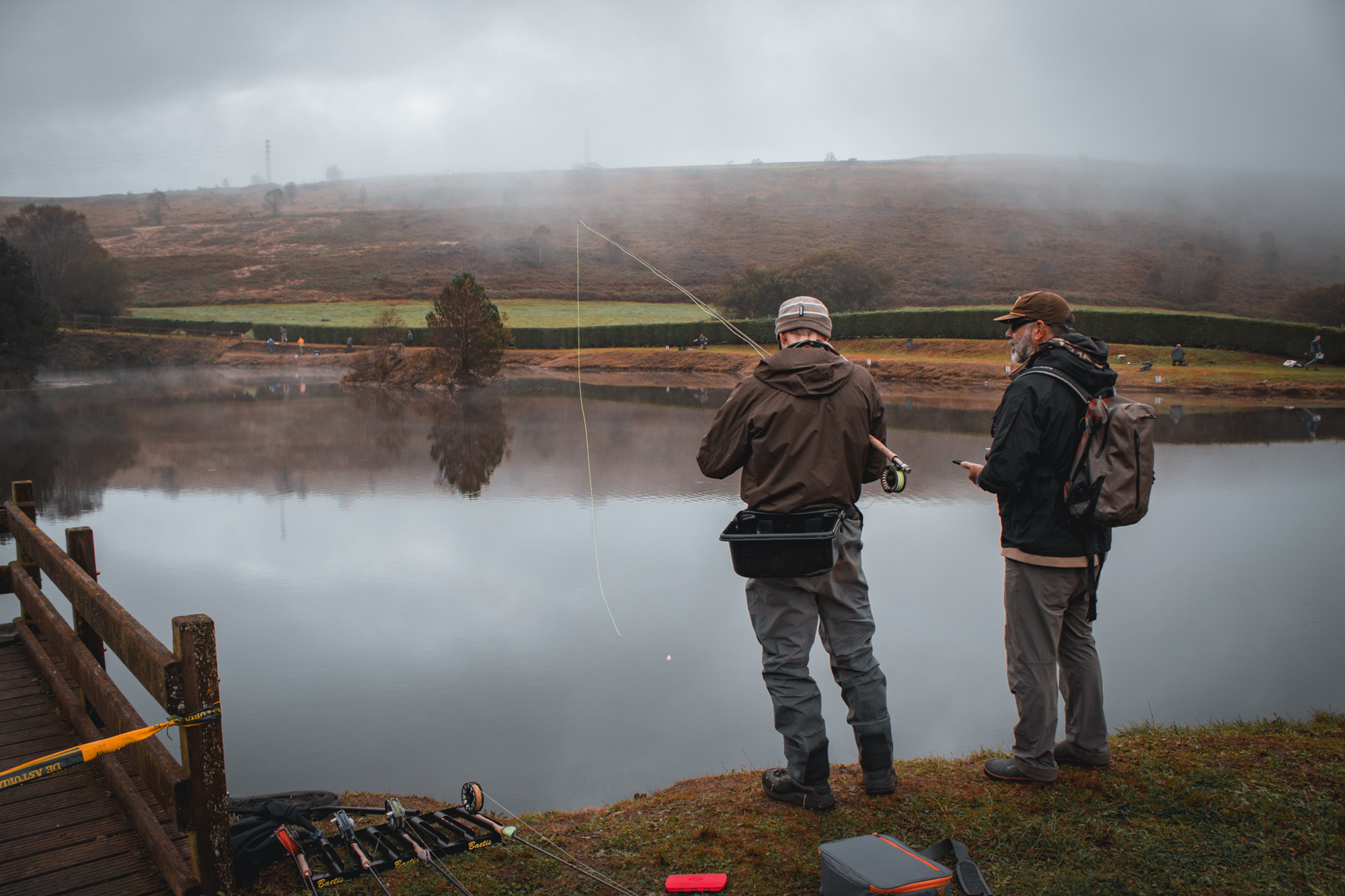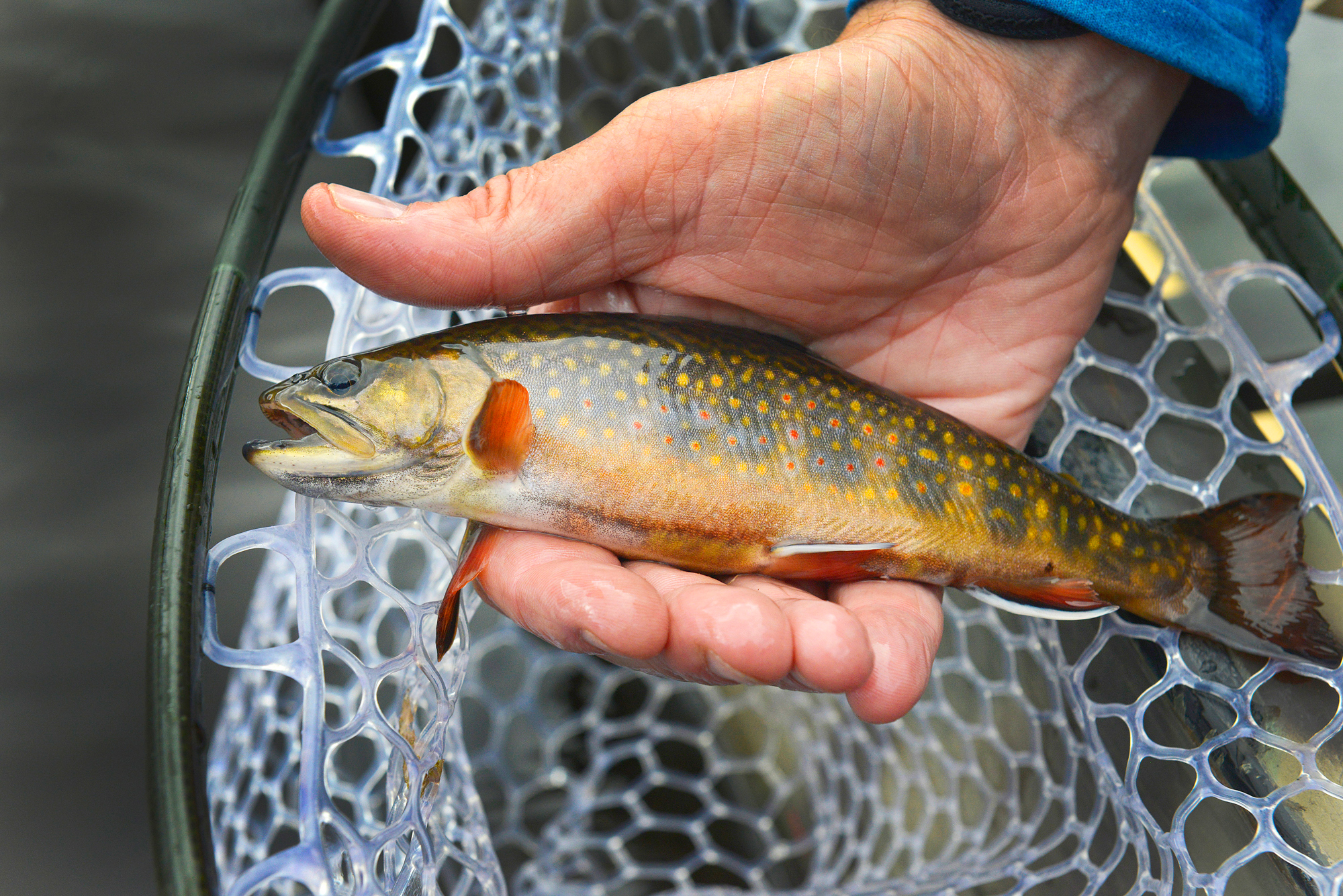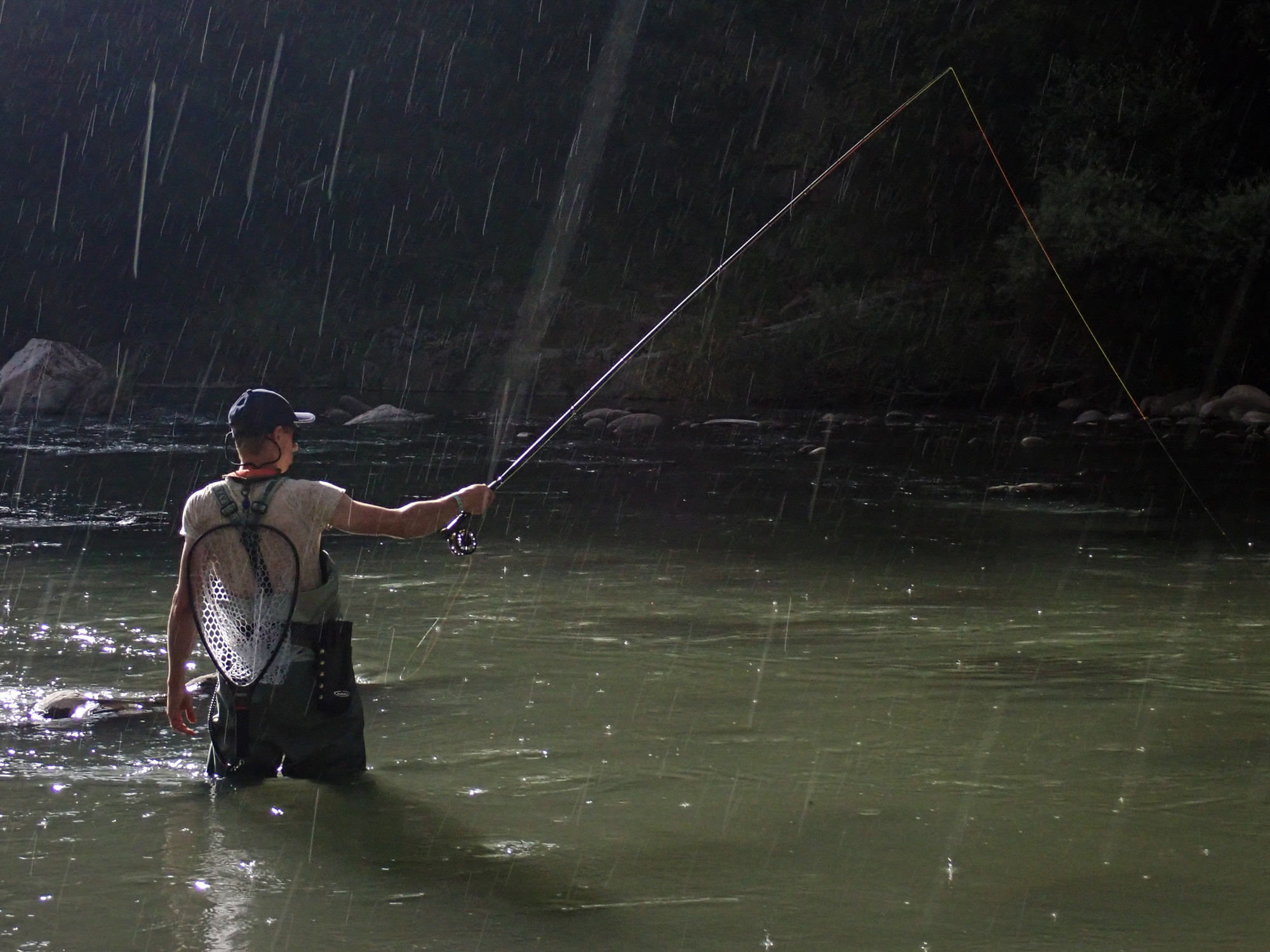I’VE BEEN getting dirty looks all day. Most of the anglers I pass on the trail don’t even say hello or ask if I’ve caught any trout. It’s a bit of a bummer because I genuinely enjoy shooting the breeze with fellow fishermen, but my decision to leave my fly rod at home and opt for an ultralight spinning rod has made me a pariah today. In just a few hours on the South Branch of the Raritan in northern New Jersey, I’ve encountered 10 other fishermen, most of them younger than me, all of them waving 10- and 11-foot Euro nymphing rods.
This technique—which requires specialized tackle and flies—has taken the fly world by storm over the past five years. It is arguably one of the most effective ways to catch numbers of trout, but the method leaves me asking: Is it truly fly fishing, or is it a crutch for a new generation of fly anglers looking for the fastest route to success? Even more intriguing to me is this question: Are the benefits of Euro nymphing so dissimilar to the benefits of fishing with spinning gear that I’m worthy of being labeled a heathen on the river?
Pond Hopping
It all started with some friendly competition. In Eastern Europe, fly fishing tracked similarly to bass fishing in the United States as a competitive sport. In 1981, the first World Fly Fishing Championship was held in Luxembourg. Since then, the event has continued to grow, attracting teams from all over the world—including the U.S.—who are looking to claim gold, silver, or bronze and earn the title of top fly anglers in the world.

The thing is, while competitive bass anglers may be racing the clock and be under far more pressure than the average angler, the tactics they employ are no different than a weekend warrior’s. Conversely, competitive fly fishing in Europe was the catalyst for developing an entirely new system of angling that bore little resemblance to traditional U.S. methods.
European-style nymphing is a catchall term for several developments in technique, including Czech nymphing, but the variants are all versions of the same premise. It’s all about tight-lining. Whereas traditional floating fly line creates drag on the water that hampers your ability to control your drift and feel subtle takes, Euro nymphing line is much thinner and more similar to monofilament, which eliminates a lot of the drag. The rods are longer, allowing you to reach farther and high-stick over a target area. Leaders can measure well north of 15 feet. Even specialized flies with tungsten heads and jig-like designs were developed to get down fast without the use of split shot.
On wild trout streams in Europe, where the fish are notoriously finicky and susceptible to being pressured into lockjaw, the system was a godsend for competitors. It allowed them to be less obtrusive, fish tighter quarters, and most importantly, instantly feel the slightest take from the smallest, most timid fish—all of which counted toward the team’s score. It wasn’t until American competitors learned and embraced the technique that our team had a fighting chance against the Europeans who had been honing their skills using this new method for much longer. And as more competitive fly anglers in the States began singing the praises of Euro nymphing, more recreational anglers started listening.
At the end of the day, anything that puts more fish in the net is good. But what Euro nymphing has done is alter the narrative of American fly fishing culture.
I have no issue with Euro nymphing as an addendum to already knowing how to cast a traditional fly line and use it to present a dry fly, nymph, or streamer. It is, after all, a highly effective technique under the right circumstances. At the end of the day, anything that puts more fish in the net is good. But what Euro nymphing has done is alter the narrative of American fly-fishing culture. The method is so effective that many folks—younger anglers especially—jump right to it without learning or mastering traditional fly tactics first. Yet on social media their accomplishments with Euro methods seem to earn them the right to consider themselves excellent fly fishermen. I say it’s difficult to even classify Euro nymphing as true fly fishing.
No Fly Zones?
My friend Anita Coulton, a Delaware River guide, fished competitively with the top-ranked team in the U.S. for seven years. She cast beside some of the pioneers of Euro nymphing and learned from them. She has also taught the tactic to many recreational anglers and witnessed firsthand how consuming it can be, especially in an era when people want instant results.
“It’s an effective way to catch fish, and I think when people see that, they go down a rabbit hole,” says Coulton. “But then that ends up being all they’re good at. I actually fell into that too when I was competing. Once you learn how to use the method and approach a piece of water like you would in competition, it’s hard not to do that. The problem is you become a one-trick pony.”

The other problem I see is that people want to apply Euro-nymphing techniques to any scenario, and that simply doesn’t work. It was developed for fishing very close. The line does not cast like a traditional floating fly line. According to Coulton, if your target zone is more than roughly 20 feet away, you can’t be effective, because the tackle is designed for short flicks and a high-stick drift in a confined zone that allows you to keep the line perfectly tight the entire time. In boulder-strewn pocket water, Euro nymphing shines; to effectively cover even a medium-size river-wide run, it does not. If suddenly you want to switch to a meaty streamer and swing it through a tailout, your Euro nymph line and rod can’t deliver. So if you believe that what makes one a good fly angler is his or her ability to cast a good distance, control drag via mending, and be versatile in terms of presentation, is Euro nymphing truly fly fishing?
“It’s up for discussion,” says Coulton. “Is it fly fishing compared to the traditional way of throwing a dry fly? I don’t think so. Can you teach it to someone fairly easily? Yes. Does it take years to refine? Absolutely.”
Stock Options
Suggesting that there is no skill involved in Euro nymphing would be completely unfair and inaccurate. I’ve tried it a few times, and if you’re already familiar with traditional fly tactics, it can be extremely frustrating. You get so used to false casting and mending and how thick fly line reacts in the water that you have to essentially retrain your brain to subtract mechanics already imprinted in your muscle memory. I actually caught on pretty quickly, but I don’t believe that happened because I’m a good fly angler. I credit it to not being married to fly fishing.
I instantly drew more parallels to spinning rod methods than the old-school nymphing methods I learned growing up. You’re still matching the hatch with your Euro flies, which has advantages at times, but I got consumed with the benefits of the presentation. I looked at it and thought, It’s all about getting down quick, keeping a tight connection, and eliminating drag—three things I can do with spinning tackle.
Remember that Euro nymphing was developed to catch large numbers of wild trout, many of them on the smaller side, in Eastern European streams. In that scenario, considering how wary those fish can be, I doubt I’d be able to go fish-for-fish against a dialed Euro nympher with my ultralight spinning rod. But on a stocked trout stream in the States, I can.
Euro nymphing on a stream featuring predominantly hatchery holdovers and fresh stockers is the equivalent of taking an Indy car to a go-kart race. You are overcomplicating the approach to catching fish that don’t require that much complexity. While Euro nymphing is slowly migrating West, it is most popular right now in the eastern half of the US. Plenty of wild trout water exists here, but I see a lot of Euro nymphing happening where the state just dumped fish last Tuesday. I get the sense that people view it as the best way to catch lots of trout, which is why I suppose it appeals to a younger generation that counts success by the number of fish in the net. And it’s also fair to say that a Euro rod might help someone feel the take of an 8-inch wild trout faster than it’ll register in my spinning rod, but then you have to ask yourself: Are you fishing for twenty 8-inchers, or are you looking for The One?
Same Old, Same Old
I’ve spent a lot of time trout fishing on the White River in Arkansas. It’s a place that’s near and dear to my heart, largely because it’s one of the few major destination rivers where conventional and fly anglers coexist in harmony. I believe the reason for that is because the shops and lodges on the White started out catering to gear anglers first, and the hardcore fly crowd latched on to the river much later.
Furthermore, the good old boys in the South were as pioneering with spin tactics as Europeans were with nymph tactics. Light-line jigging techniques were developed here. Using long, sensitive spinning rods and line testing as little as 2 pounds, anglers could fire very small marabou jigs and make them dance by jigging with slack in their line. It was highly effective then, and today it’s widely accepted as a smart way to catch numbers of trout. Will a 10-pound brown occasionally smack one of those jigs? Of course. But if you’re goal is to fool a Goliath on the White, throwing bigger lures is the way to go.
After my first time jigging the White with veteran guide Mike Neher, I couldn’t wait to get home to adapt some of what I’d learned to my home water. I re-spooled with 2-pound line. I picked up a 7 ½-foot ultralight rod with a soft tip. I bought a smattering of tiny marabou jigs and Trout Magnets, which are soft-plastic lures shaped like a mealworm. At the time, I was utterly devoted to trout on the fly, but when winter rolled around, I decided to leave the nymphing gear at home and just head out with my newly refigured spinning outfit. I caught more trout in a single day than I had during any previous winter.
Is it fly fishing compared to the traditional way of throwing a dry fly? I don’t think so. Can you teach it to someone fairly easily? Yes. Does it take years to refine? Absolutely.
If you look at the rig I’m using, it’s not so dissimilar to a Euro nymphing rig. On the bottom I’ll use a Trout Magnet, which is very similar in size and weight to a large stonefly pattern. Above that I’ll run a short dropper leader that holds another nymph like a Prince or Hare’s Ear. Then up the line I’ll add a tiny adjustable indictor made of foam—something also commonly used in fly fishing. The difference between this setup and a Euro nymphing outfit is that I’m not forced to fish a single run, eddy, or pocket that’s at rod’s length or just beyond. I can cover more water, especially in the winter, when I can fish more comfortably because I’m not handing wet fly line. After a few seasons of fishing this way, I decided I was done nymphing altogether. I was effectively doing the same thing, just much more efficiently—which brings me back to those nasty looks I was getting on the river.
I’m a firm believer in fishing in whatever manner makes you happy. If it’s more gratifying to catch a trout on the fly, then you should be fly-or-die. If you’d rather drift a nightcrawler, save one for me because I have no problem with throwing fresh meat. But what the uptick in Euro nymphing popularity has done, at least to my eye, is widen the gap between the fly and conventional angling worlds more than ever before.
The reality is that the practice draws just as much from conventional techniques and gear as it does from traditional fly techniques and gear. There are lures these days that are small and light enough to be cast on a fly rod, that mimic the same prey and flies, but the idea of crossing that line for the average fly guy is still very icky.
Had a few of those anglers asked how I was doing instead of giving me the cold shoulder, I could have told them to put on pink Squirmy Worm flies because pink Trout Magnets were crushing. I could have told them that the wild browns in the system were more interested in olive that day. I could have also told them that the biggest fish I caught smacked a 4-inch Rapala Jerkbait. But even if I had a Dungeon streamer or Junkyard Dog in my pack to give them, they wouldn’t have gotten it where it needed to go on that Euro line.
Read more OL+ stories.
